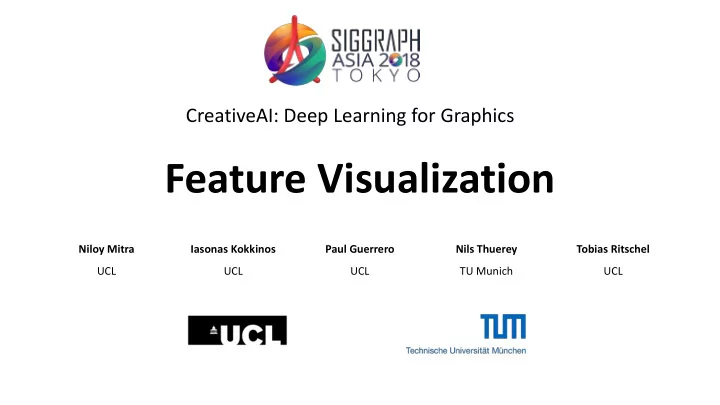

CreativeAI: Deep Learning for Graphics Feature Visualization Niloy Mitra Iasonas Kokkinos Paul Guerrero Nils Thuerey Tobias Ritschel UCL UCL UCL TU Munich UCL
Timetable Niloy Paul Nils Introduction 2:15 pm X X X ∼ 2:25 pm Machine Learning Basics X and Basics Theory ∼ 2:55 pm Neural Network Basics X Feature Visualization ∼ 3:25 pm X Alternatives to Direct Supervision ∼ 3:35 pm X 15 min. break of the Art Image Domains 4:15 pm X State 3D Domains ∼ 4:45 pm X ∼ 5:15 pm Motion and Physics X ∼ 5:45 pm Discussion X X X SIGGRAPH Asia Course CreativeAI: Deep Learning for Graphics 2
What to Visualize • Features (activations) • Weights (filter kernels in a CNN) • Attribution: input parts that contribute to a given activation • Inputs that maximally activate some class probabilities or features • Inputs that maximize the error (adversarial examples) SIGGRAPH Asia Course CreativeAI: Deep Learning for Graphics 3
feature channels Feature Samples • In good training, features are usually sparse spatial height • Can find “dead” features that never activate spatial width Images from: http://cs231n.github.io/understanding-cnn/ SIGGRAPH Asia Course CreativeAI: Deep Learning for Graphics 4
Feature Distribution using t-SNE • Low-dimensional embedding of the features for visualization before training after training t-SNE embedding of image features t-SNE embedding of MNIST (images of digits) features in a CNN layer, colored by class in a CNN layer Images from: https://cs.stanford.edu/people/karpathy/cnnembed/ and Rauber et al. Visualizing the Hidden Activity of Artificial Neural Networks . TVCG 2017 SIGGRAPH Asia Course CreativeAI: Deep Learning for Graphics 5
Feature Distribution using t-SNE • Low-dimensional embedding of the features for visualization evolution during training t-SNE embedding of image features t-SNE embedding of MNIST (images of digits) features in a CNN layer, colored by class in a CNN layer Images from: https://cs.stanford.edu/people/karpathy/cnnembed/ and Rauber et al. Visualizing the Hidden Activity of Artificial Neural Networks . TVCG 2017 SIGGRAPH Asia Course CreativeAI: Deep Learning for Graphics 6
Weights (Filter Kernels) • Useful for CNN kernels, not useful for fully connected layers • Kernels are typically smooth and diverse after a successful training conv kernel height kernel width first layer filters of AlexNet input channels * output channels Images from: http://cs231n.github.io/understanding-cnn/ SIGGRAPH Asia Course CreativeAI: Deep Learning for Graphics 7
Code Examples Filter Visualization http://geometry.cs.ucl.ac.uk/creativeai 8
Attribution by Approximate Inversion • Reconstruct Input from a given feature channel • What information does the feature channel focus on? Zeiler and Fergus, Visualizing and Understanding Convolutional Networks , ECCV 2014 SIGGRAPH Asia Course CreativeAI: Deep Learning for Graphics 9
Perturbation-based Attribution Probability for correct classification when centering the box at each pixel. Zeiler and Fergus, Visualizing and Understanding Convolutional Networks , ECCV 2014 SIGGRAPH Asia Course CreativeAI: Deep Learning for Graphics 10
Gradient-based Attribution • Derivative of class probability w.r.t input pixels • Which parts of the input is the class probability sensitive to? Smilkov et al., SmoothGrad: removing noise by adding noise , arXiv 2017 SIGGRAPH Asia Course CreativeAI: Deep Learning for Graphics 11
Inputs that Maximize Feature Response Local maxima of the response for class: Indian Cobra Pelican Ground Beetle Images from: Yosinski et al. Understanding Neural Networks Through Deep Visualization . ICML 2015 SIGGRAPH Asia Course CreativeAI: Deep Learning for Graphics 12
Inputs that Maximize the Error “Panda” 55.7% conf. “Gibbon” 99.3% conf. Images from: Goodfellow et al. Explaining and Harnessing Adversarial Examples . ICLR 2015 SIGGRAPH Asia Course CreativeAI: Deep Learning for Graphics 13
Course Information (slides/code/comments) http://geometry.cs.ucl.ac.uk/creativeai/ SIGGRAPH Asia Course CreativeAI: Deep Learning for Graphics 14
Recommend
More recommend